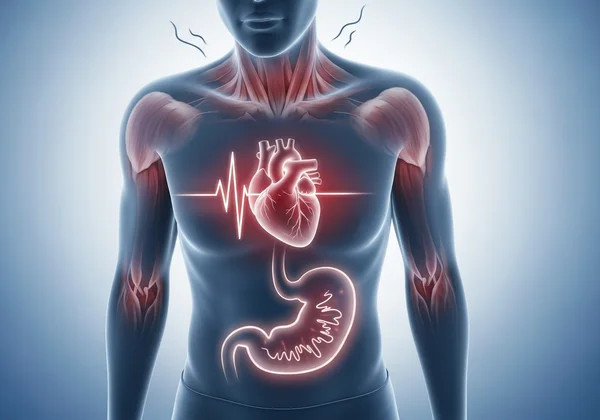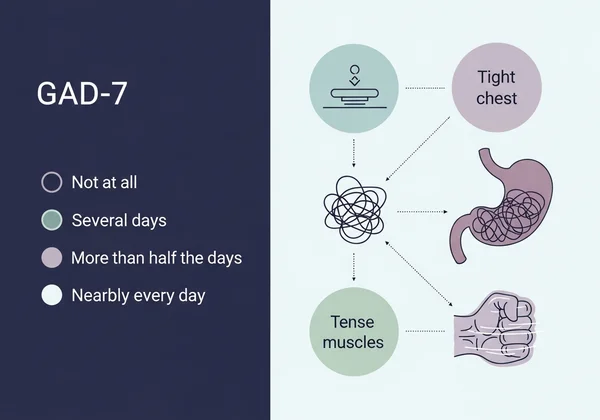Physical Symptoms of Anxiety: How GAD7 Manifests
Ever feel your heart race before a big presentation, your stomach churn with worry, or your muscles tense up for no apparent reason? You're not just "in your head." These sensations are real, tangible proof that anxiety is a full-body experience. The intricate link between our minds and bodies means that emotional distress often shows up as physical discomfort. Understanding these signals is the first step toward managing them. So, what are the physical symptoms of anxiety telling you?
In this article, we'll dive into the science behind anxiety's physical toll, connecting common bodily sensations directly to the questions on the Generalized Anxiety Disorder 7-item (GAD-7) scale. Our goal is to validate what you're feeling, help you understand your body's unique language, and show you how a tool like the confidential GAD-7 assessment can be a powerful ally on your path to feeling better.
Why Anxiety Causes Physical Symptoms in the Body
To understand why your palms get sweaty or your chest feels tight, we need to look at our body's ancient, hard-wired survival system. Anxiety is essentially this system kicking into overdrive, preparing you for a threat that may be emotional or psychological rather than a physical danger.

Understanding the Fight-or-Flight Response
At the heart of anxiety's physical toll is the fight-or-flight response. This is your sympathetic nervous system's automatic reaction to a perceived threat. When your brain senses danger—whether it's a looming deadline, a difficult conversation, or a chronic worry—it triggers a cascade of physiological changes designed to help you either confront the threat or flee to safety. Your body is flooded with energy and becomes hyper-alert, a state that is incredibly useful in short bursts but exhausting and damaging when sustained over time, as is often the case with chronic anxiety.
The Role of Stress Hormones: Cortisol and Adrenaline
The fight-or-flight response is powered by two key stress hormones: cortisol and adrenaline. Adrenaline gives you that immediate surge of energy. It increases your heart rate to pump more blood to your muscles, quickens your breathing to boost oxygen intake, and sharpens your senses. Cortisol, the primary stress hormone, is released to sustain this state of high alert. It keeps your body on guard by releasing sugar into your bloodstream for quick energy and curbing functions it deems non-essential in a crisis, like digestion and immune response. When you live with anxiety, this system can be constantly active, leading to the persistent physical symptoms you experience.
Common Physical Manifestations Linked to GAD-7
The GAD-7 questionnaire is a powerful tool because its questions, while seemingly focused on feelings, are directly linked to the physical fallout of anxiety. Let's break down how these common symptoms connect to the assessment. If you recognize these feelings, it may be helpful to start your free assessment to see how they score.

Your Mind & Muscles: Tension, Restlessness, and Fatigue
One of the first questions on the GAD-7 asks about "being so restless that it is hard to sit still." This isn't just a feeling; it's muscle tension. When your body is in a state of high alert, your muscles contract, ready for action. Over time, this chronic tension leads to persistent aches, particularly in the neck, shoulders, and back. It can also manifest as jaw clenching, tension headaches, and a general feeling of being physically "on edge." This constant state of readiness is draining, which is why fatigue anxiety is so common. You feel tired all the time because your body is perpetually running a marathon you never signed up for.
When Your Stomach Churns: Nausea, Digestion, and Pain
Do you often experience an upset stomach when you're worried? There's a reason for that. During the fight-or-flight response, your body diverts blood away from the digestive system to your large muscles. This slowdown can cause a wide range of gastrointestinal issues, which is why anxiety stomach pain is one of the most frequently reported symptoms. You might experience nausea, cramping, diarrhea, constipation, or even a link to conditions like Irritable Bowel Syndrome (IBS). That "butterflies in your stomach" feeling is your digestive system reacting directly to your stress hormones.
Heart & Breath: Chest Tightness, Palpitations, and Shortness of Breath
Perhaps the most frightening physical symptoms are those related to the heart and lungs. Anxiety chest pain or a feeling of anxiety chest tightness can be terrifying because it often mimics symptoms of a heart attack. This sensation is typically caused by the tensing of chest muscles and hyperventilation (rapid, shallow breathing). Adrenaline also causes a rapid heartbeat anxiety, known as palpitations, as your heart works harder to circulate blood. This can feel like your heart is pounding, fluttering, or skipping a beat. While deeply unsettling, these symptoms are a standard part of the body's anxiety response.
Other Unsettling Body Signals: Headaches, Tremors, and Dizziness
Anxiety's reach doesn't stop there. The persistent muscle tension can lead to frequent anxiety headaches, especially tension headaches that feel like a tight band around your head. The surge of adrenaline can also cause anxiety tremors or shaking in your hands and limbs. Furthermore, changes in breathing patterns can affect the oxygen and carbon dioxide levels in your blood, leading to lightheadedness and anxiety dizziness. These varied symptoms show just how comprehensively anxiety can impact your physical well-being.
Connecting Your Body's Signals to the GAD-7 Score
Recognizing these physical symptoms is crucial, but quantifying them can provide clarity and a path forward. This is where the online GAD-7 tool becomes invaluable. It helps translate your confusing physical experiences into a clear, understandable score.
How GAD-7 Questions Mirror Your Physical Experience
The GAD-7 assessment asks you to rate how often you've been bothered by issues like "feeling nervous, anxious or on edge," "not being able to stop or control worrying," and "trouble relaxing." At first glance, these seem purely mental. However, as we've explored, these states are inextricably linked to physical responses. "Trouble relaxing" is chronic muscle tension. "Feeling on edge" is your nervous system in overdrive. "Worrying" fuels the release of stress hormones that cause stomach pain and a racing heart. The GAD-7 brilliantly uses these psychological indicators as proxies to measure the underlying physiological distress.
Why Recognizing These Signs is Your First Step
Acknowledging that your physical pain could be linked to anxiety is an empowering realization. It's not "all in your head," and you're not imagining it. Your body is sending you valid signals that something is out of balance. Using a scientifically validated screening tool like the GAD-7 gives you a private, immediate way to assess these signals. It provides a baseline score that can help you understand the severity of your symptoms and facilitate a more productive conversation with a healthcare professional. Taking this first step can reduce fear and uncertainty, replacing it with knowledge and a clear direction.
Empowering Your Journey: Listening to Your Body's Signals
Your body speaks a language, and the physical symptoms of anxiety are its way of telling you it's under stress. From a churning stomach to a racing heart, these are not imagined weaknesses but real physiological responses to a state of high alert. By understanding the fight-or-flight response and the role of stress hormones, you can begin to demystify these unsettling sensations.
Remember, acknowledging these signs is a sign of strength. They are your cue to listen more closely and take proactive steps toward well-being.

If the descriptions in this article resonate with you, taking a confidential GAD-7 assessment can be a valuable first step in understanding your anxiety level. It’s quick, free, and provides immediate results to help you make sense of your experience. Start your free, immediate assessment now.
Disclaimer: This article is for informational purposes only. The GAD-7 is a screening tool, not a diagnostic instrument. Always consult a qualified medical professional to rule out other health conditions and for a comprehensive diagnosis and treatment plan.
Frequently Asked Questions About Anxiety's Physical Manifestations and GAD-7
What are the most common physical symptoms of anxiety?
The most common physical symptoms include a rapid heartbeat, shortness of breath, chest tightness, stomach pain or nausea, muscle tension, headaches, fatigue, trembling, and dizziness. These occur because your body's "fight-or-flight" response is activated, preparing you for a perceived threat.
Can physical symptoms of anxiety be dangerous or a sign of another serious illness?
While the physical symptoms of anxiety are typically not dangerous on their own, they can be very distressing and can overlap with symptoms of other serious medical conditions, such as heart disease. It is crucial to consult a doctor to rule out any other underlying health issues, especially if you experience new or severe symptoms like chest pain.
How does the GAD-7 test help identify my physical anxiety symptoms?
The GAD-7 assesses the frequency of key anxiety indicators like restlessness, irritability, and trouble relaxing. These feelings are directly tied to physical states such as muscle tension, fatigue, and an overactive nervous system. By scoring these experiences, the test provides a reliable measure of the overall severity of your anxiety, which encompasses both its emotional and physical components. The GAD-7 assessment helps quantify what you're feeling.
Is the GAD-7 a diagnosis for physical anxiety or other medical conditions?
No. The GAD-7 is a highly respected and scientifically validated screening tool, but it is not a diagnosis. It is designed to help you and your healthcare provider quickly assess the potential presence and severity of anxiety symptoms. A formal diagnosis can only be made by a qualified healthcare professional after a thorough evaluation.
What should I do if I am experiencing significant physical symptoms of anxiety?
First, see a doctor to rule out any other medical causes. If your symptoms are determined to be anxiety-related, discussing your results from a tool like the GAD-7 can be a great starting point for a conversation about next steps. This may include therapy, lifestyle changes like exercise and mindfulness, or other treatment options recommended by your provider.